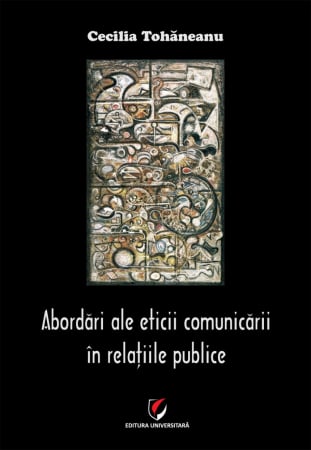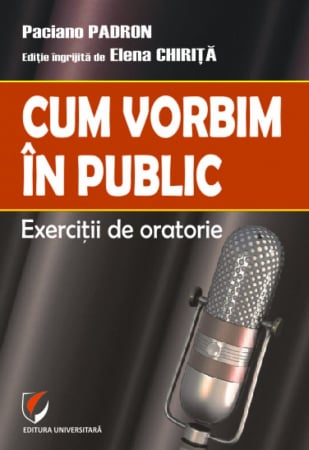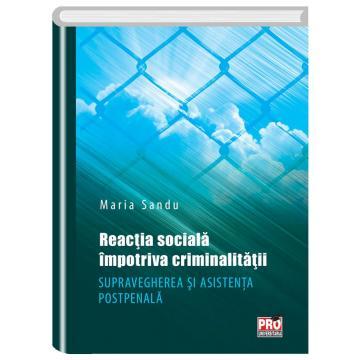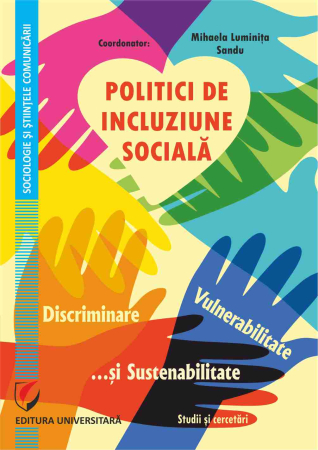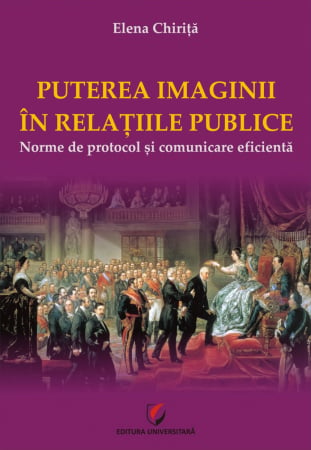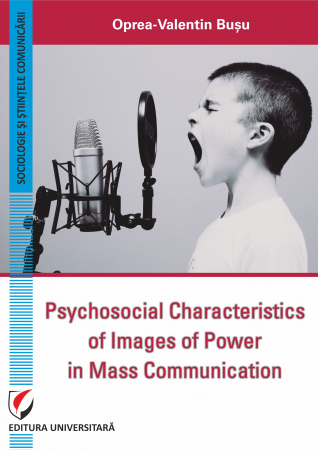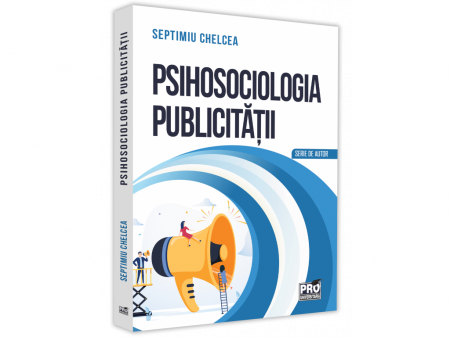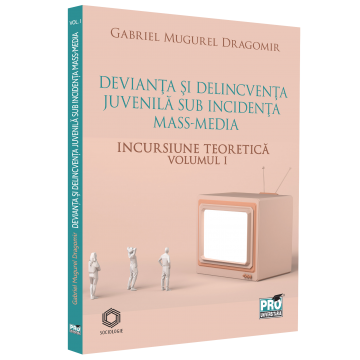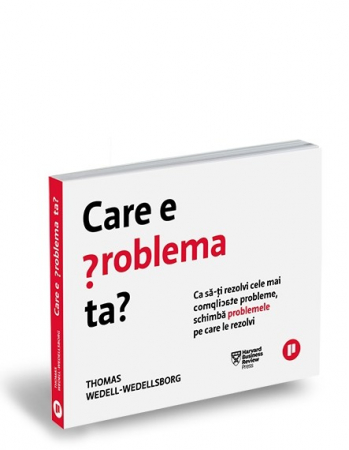Manuscript proposals: [email protected] / 0745 204 115 //// Tracking orders Individuals / Sales: 0745 200 357 / Orders Legal entities: 0721 722 783
Publisher: Editura Universitară
Author: Nina Stanescu
ISBN: 978-606-28-1288-1
DOI: https://doi.org/10.5682/9786062812881
Publisher year: 2021
Edition:
Pages: 424
Product Code:
9786062812881
Do you need help?
0745 200 357
- Description
- Download (1)
- Authors
- Content
- More details
- Reviews (0)
The work of Mrs. Nina Stanescu is a monograph of a settlement both social and spiritual after the model of the one invented by St. Basil the Great in Caesarea in Cappadocia. The unexplained intention of the author is a hermeneutic one: to research the validation of the prototype of such a settlement over the centuries, at over 1600 years, in a late Romanian one, built at the bend of Buzau, based on the first from and through which they bore fruit. the spiritual toils and martyrdom of another great saint from the East, from the Lower Danube, this time, St. Sava from Buzau.
According to the author, the new settlement was conceived from the archetype of the vassalship of St. Basil the Great and bears a name built according to the same pattern, Savaliada. In the author's hypothesis, such an establishment grows from the pneumatological body, so alive, of a saint because the saints do not die, they remain here when they pass beyond, the martyr's sanctification being a testimony, but also the subsequent and previous miracles of the saint. This is the reason for the author's perseverance on the theological and practical work of St. Basil the Great, in the first section of his monographic book. If you want to understand the transreal springs of such unusual deeds, as are those at the foundation and inside of these settlements, it is absolutely necessary to start from the teaching of St. Basil who tells us that in these settlements find shelter physically, spiritually and the poor, the sick, the oppressed and the oppressed are spiritual, that is, those in whom, as the Great Basil says, and the author repeats, "Christ lives."
The first attribute of an establishment like Savaliada (and therefore its prototype, Vasiliada), is that it mediates the encounter with Christ in the oropsite and humiliation of life, as the unparalleled poet says in a quatrain sprung from the spirit of the same evangelical life, as attested by these establishments: "You can hear far away the cries of the weak / and the oppressed towards us // it is the voice of the gentle Bessarabia / reached in the last century". After presenting the ideas of the Great Basil and the principles of Vasiliade, which St. Gregory the Theologian considered one of the wonders of antiquity (precisely for the unusual spiritual triumph illustrated by such a mixed institution, completely unusual for the times of glorious Greco-Roman antiquity, of the soul), the author makes a presentation of Savaliada, that is, of the “St. Sava Foundation from Buzau”, built under the educational and spiritual guidance of the tireless founding father, Fr. Prof. Dr. Milea Mihail.
This part of the monograph is based on a methodology specific to photographic, epistolary and documentary sociography. The procedures are known. The monumental work of Thomas and Znaniecki (keeping the proportions, of course) is elaborated on the epistolary support of the Polish peasants from America to their families from Poland. Dimitrie Gusti inaugurated the filmed sociology and obviously the photographic material is frequently used in the researches of the crews of the Gustian village monographs.
Mrs. Nina Stanescu's work is also distinguished by the courage of the book-making formula. Dansa dares to compose the living picture of this settlement, reason for which we will find in the corpus of the monograph his spiritual realities led by the most representative: with the Akathist St. Sava from Buzau, continuing with the epistolary of the discovery of holy relics and interviews that are the living mirror of this extraordinary settlement.
The work is not elaborated out of any ostentatious longing, although the settlement is extraordinary. The author opted for a strategy typical of a humble monograph: the author stays in the shadows, in the background, to leave in the foreground the charismatic characters of the two saints, followed by those who worked hard to make this settlement led by the one who it is, however, its most dynamic part, Fr. Prof. Milea himself, together with all the brothers, with the extremely important volunteers for the life of the settlement and, last but not least, with its inhabitants who are also confessors.
The monograph is distinguished, therefore, by the iconographic material (photographic sociology), by the epistolary, spiritual documentary, by the akathist file, by the file of documents, interviews and an exploratory micro-survey based on a questionnaire of spiritual knowledge applied to theological students.
The noological method used to evoke the picture of savaliada deserves a special word. This innovation is completely surprising, extremely interesting, and would deserve independent developments (perhaps in a separate paper).
I consider that the work of Mrs. Nina Stanescu is highly contributory, masterfully made, serving for the knowledge of a highly edifying and enlightening practice for the work of philanthropy and church diakonia within the diocese of which the St. Sava Foundation from Buzau is part.
Academician, Prof. Dr. Ilie Badescu
March 17, 2019, celebration
Saint Alexie
According to the author, the new settlement was conceived from the archetype of the vassalship of St. Basil the Great and bears a name built according to the same pattern, Savaliada. In the author's hypothesis, such an establishment grows from the pneumatological body, so alive, of a saint because the saints do not die, they remain here when they pass beyond, the martyr's sanctification being a testimony, but also the subsequent and previous miracles of the saint. This is the reason for the author's perseverance on the theological and practical work of St. Basil the Great, in the first section of his monographic book. If you want to understand the transreal springs of such unusual deeds, as are those at the foundation and inside of these settlements, it is absolutely necessary to start from the teaching of St. Basil who tells us that in these settlements find shelter physically, spiritually and the poor, the sick, the oppressed and the oppressed are spiritual, that is, those in whom, as the Great Basil says, and the author repeats, "Christ lives."
The first attribute of an establishment like Savaliada (and therefore its prototype, Vasiliada), is that it mediates the encounter with Christ in the oropsite and humiliation of life, as the unparalleled poet says in a quatrain sprung from the spirit of the same evangelical life, as attested by these establishments: "You can hear far away the cries of the weak / and the oppressed towards us // it is the voice of the gentle Bessarabia / reached in the last century". After presenting the ideas of the Great Basil and the principles of Vasiliade, which St. Gregory the Theologian considered one of the wonders of antiquity (precisely for the unusual spiritual triumph illustrated by such a mixed institution, completely unusual for the times of glorious Greco-Roman antiquity, of the soul), the author makes a presentation of Savaliada, that is, of the “St. Sava Foundation from Buzau”, built under the educational and spiritual guidance of the tireless founding father, Fr. Prof. Dr. Milea Mihail.
This part of the monograph is based on a methodology specific to photographic, epistolary and documentary sociography. The procedures are known. The monumental work of Thomas and Znaniecki (keeping the proportions, of course) is elaborated on the epistolary support of the Polish peasants from America to their families from Poland. Dimitrie Gusti inaugurated the filmed sociology and obviously the photographic material is frequently used in the researches of the crews of the Gustian village monographs.
Mrs. Nina Stanescu's work is also distinguished by the courage of the book-making formula. Dansa dares to compose the living picture of this settlement, reason for which we will find in the corpus of the monograph his spiritual realities led by the most representative: with the Akathist St. Sava from Buzau, continuing with the epistolary of the discovery of holy relics and interviews that are the living mirror of this extraordinary settlement.
The work is not elaborated out of any ostentatious longing, although the settlement is extraordinary. The author opted for a strategy typical of a humble monograph: the author stays in the shadows, in the background, to leave in the foreground the charismatic characters of the two saints, followed by those who worked hard to make this settlement led by the one who it is, however, its most dynamic part, Fr. Prof. Milea himself, together with all the brothers, with the extremely important volunteers for the life of the settlement and, last but not least, with its inhabitants who are also confessors.
The monograph is distinguished, therefore, by the iconographic material (photographic sociology), by the epistolary, spiritual documentary, by the akathist file, by the file of documents, interviews and an exploratory micro-survey based on a questionnaire of spiritual knowledge applied to theological students.
The noological method used to evoke the picture of savaliada deserves a special word. This innovation is completely surprising, extremely interesting, and would deserve independent developments (perhaps in a separate paper).
I consider that the work of Mrs. Nina Stanescu is highly contributory, masterfully made, serving for the knowledge of a highly edifying and enlightening practice for the work of philanthropy and church diakonia within the diocese of which the St. Sava Foundation from Buzau is part.
Academician, Prof. Dr. Ilie Badescu
March 17, 2019, celebration
Saint Alexie
-
Civitas Deo. Monograph of the "Saint Sava" Foundation from Buzau
Download
NINA STANESCU doctor in sociology, "teacher" at the University of Constanta.
Articles, interdisciplinary publications.
Areas: sociology, legal sciences, theology, social work.
Representative works:
Techirghiol - Appeal to the Collective Memory
The social mission of the Romanian Orthodox Church, awarded (2012) within ENIGEL - Resource Center for Scientific Authorization and Interdisciplinary Oriented Research Bucharest, University of Bucharest, for the study of noological sociology
Tabs from a journal called LIFE
Articles, interdisciplinary publications.
Areas: sociology, legal sciences, theology, social work.
Representative works:
Techirghiol - Appeal to the Collective Memory
The social mission of the Romanian Orthodox Church, awarded (2012) within ENIGEL - Resource Center for Scientific Authorization and Interdisciplinary Oriented Research Bucharest, University of Bucharest, for the study of noological sociology
Tabs from a journal called LIFE
Prequantation / 9
Paper on the monographic paper / 11
Outline / 15
Synthesis / 19
Word / 23
Part I / 25
1. "The word that builds, the hand that works" / 27
2. The social philanthropic activity of Saint Basil the Great / 36
3. Vasiliada - The tabernacle of God, the tabernacle of almsgiving / 39
4. Why "Vasiliada - a miracle of the Christian world"? / 43
5. The actuality of the social philanthropic mission in the work of Saint Basil the Great / 46
Part II / 55
6. The charismatic genealogy of savaliada from the perspective of noological sociology / 57
7. Geohistorical identity noology of Saint Sava Gotul / 58
8. The pneumatological body, the gradient of holiness - The relics of Saint Sava Gotul / 91
9. The path of love - sacred geography / 92
10. Documents attesting the authenticity of the relics of Saint Sava Gotul / 103
11. Lesje Monastery - the place where the Relics of Saint Sava from Buzau are located / 108
12. The Samaritan priest - Fr. Prof. Dr. Milea Mihail, President of the Foundation "Saint Sava of Buzau" / 113
13. Vocational Project - life-giving project: "Children - Founders of the Municipal Cathedral of St. Sava of Buzau" / 148
14. Saint Sava Foundation from Buzau - Institution with Legal Personality / 153
14.1. Cantina Sociala / 161
14.2. Family Violence Emergency Center, „St. Mc. Sava de la Buzau ”/ 162
14.3. Collection interview - Cravcevschi Oprica / 185
14.4. School of Arts and Crafts / 188
14.5. After School, "Ceainaria Bucuriei" Volunteer Center / 189
14.6. Romanian Orthodox Institute of Creationist Sciences, Sfantul Sava Publishing House / 201
14.7. Sfantul Sava Foundation Library / 204
14.8. The financial accounting management service of the Foundation „St. Sava ”de la Buzau / 206
14.9. Impressions, Opinions, Ideas ... Interview with volunteers of the Foundation „St. Sava ”from Buzau (Focus Group Method) / 210
15. The Social Settlements of the Foundation “St. Sava ”de la Buzau / 214
15.1. Settlements for the Elderly (A.P.V.) “St. Sava ”Campeni / 214
15.1.1. Statistical Social Note to A.P.V. Campeni / 217
15.1.2. Interview coordinator A.P.V. Campeni / 220
15.1.3. Beneficiaries A.P.V. Campeni / 222
15.1.4. Life stories (interview with beneficiaries A.P.V Campeni) / 223
15.2. The Settlement for the Elderly “St. Sava ”de la Naeni / 234
15.2.1. The settlement for the elderly from Naeni / 235
15.2.2. Statistical Social Note to A.P.V. Naeni / 237
15.2.3. Interview coordinator A.P.V. Naeni / 238
15.2.4. Beneficiaries A.P.V. Naeni / 241
15.2.5. Life stories (interview with beneficiaries A.P.V. Naeni) / 242
15.3. Settlement for the Elderly (Men) “St. Sava ”Ulmeni Pietroasele / 253
15.3.1. Statistical Social Note to A.P.V. Ulmeni Pietroasele / 254
15.3.2. Interview coordinator A.P.V. Ulmeni Pietroasele / 255
15.3.3. Beneficiaries A.P.V. Ulmeni Pietroasele / 257
15.3.4. Life stories (interview with beneficiaries A.P.V. Ulmeni Pietroasele) / 259
15.4. Social Center for People with Special Needs (C.S.P.P.N.S.), Mosesti Village, Robeasca Commune, “St. Sava ”de la Buzau / 265
15.4.1. Statistical Social Note C.S.P.P.N.S. Mosesti village, Robeasca commune / 266
15.4.2. Interview Administrator C.S.P.P.N.S. Mosesti village, Robeasca commune / 267
15.4.3. Beneficiaries of C.S.P.P.N.S. Mosesti village, Robeasca commune / 268
15.4.4. Life stories (Interview with the beneficiaries of C.S.P.P.N.S. Mosesti - Robeasca) / 269
15.5. Savaliada de la Baba Ana, nostalgia vindicativa a Vasiliadei / 279
15.5.1. True stories from Baba Ana / 283
15.5.2.Volunteer Beneficiary la Savaliada de la Baba Ana / 284
16. The campuses of the “Saint Sava” Foundation from Buzau / 293
16.1. Bisoca / 293
16.1.1. Bisoca Day Center, „St. Sava ”de la Buzau / 294
16.1.2. The campus for children from Bisoca, “St. Sava ”de la Buzau / 295
16.1.3. Bisoca Summer School / 299
16.2. Youth camp ,, St. Sava ”from Maliuc, Tulcea county / 308
Part III / 313
17. Bessarabia - the frontier of the spirit, the frontier of threefold love: of God, of fellow men, of nation / 325
17.1. May 31, 2012 First Twinning Agreement Buzau (Romania) - Soroca (Bessarabia) / 326
17.2. Buzau (Romania) - Soroca (Bessarabia), Twinning Agreement Forever / 327
17.2.1. Joy for the victims. Santa Claus in Soroca (Bessarabia) / 329
17.2.2. Honoring the fallen heroes in the fight for the reconquest of Bessarabia, Stoicani Cemetery / 329
17.2.3. Romanian Library of Soroca / 331
17.2.4. The first Church of the Metropolitan Church of Bessarabia in Soroca district / 331
17.2.5. Church of the Holy Martyrs Brancoveni from Soroca, Bessarabia / 333
17.2.6. Orantis Soroca Choir / 336
17.3. Grigore Vieru - Apostle of the Romanian Language / 337
17.4. Ana Bejan - a brand name for Bessarabia and Romania / 340
17.4.1. Ana Bejan - the representative of Bessarabia „active, constant and faithful presence in the projects of the„ Sfantul Sava ”Foundation from Buzau / 340
NOOLOGICAL FRAMES / 348
18. On the way to the Dacian Village. Pietroasele - The cradle of my childhood / 348
18.1. Pietroasele - area of calcareous rocks and "sap" of Tamaioasa Dacica / 348
18.2. The stony dense noological space, in which the stones speak / 349
18.3. Golden Chicken Nest treasure, legend, curse / 351
18.4. Pietroasele's life story The cradle of my childhood. Latent souls / 353
18.5. Noological realities. Interview with nea Ion Moaca, carver and lover of beauty from Pietroasele / 361
19. Dacian village, "Saint Sava" Foundation from Buzau. Contemporary Sociological Experiment / 365
19.1. Noological frames or places specific to the Dacian village / 366
19.2. Life stories from the Dacian Village / 368
20. Instead of an epilogue / 384
Selective bibliography / 419
Paper on the monographic paper / 11
Outline / 15
Synthesis / 19
Word / 23
Part I / 25
1. "The word that builds, the hand that works" / 27
2. The social philanthropic activity of Saint Basil the Great / 36
3. Vasiliada - The tabernacle of God, the tabernacle of almsgiving / 39
4. Why "Vasiliada - a miracle of the Christian world"? / 43
5. The actuality of the social philanthropic mission in the work of Saint Basil the Great / 46
Part II / 55
6. The charismatic genealogy of savaliada from the perspective of noological sociology / 57
7. Geohistorical identity noology of Saint Sava Gotul / 58
8. The pneumatological body, the gradient of holiness - The relics of Saint Sava Gotul / 91
9. The path of love - sacred geography / 92
10. Documents attesting the authenticity of the relics of Saint Sava Gotul / 103
11. Lesje Monastery - the place where the Relics of Saint Sava from Buzau are located / 108
12. The Samaritan priest - Fr. Prof. Dr. Milea Mihail, President of the Foundation "Saint Sava of Buzau" / 113
13. Vocational Project - life-giving project: "Children - Founders of the Municipal Cathedral of St. Sava of Buzau" / 148
14. Saint Sava Foundation from Buzau - Institution with Legal Personality / 153
14.1. Cantina Sociala / 161
14.2. Family Violence Emergency Center, „St. Mc. Sava de la Buzau ”/ 162
14.3. Collection interview - Cravcevschi Oprica / 185
14.4. School of Arts and Crafts / 188
14.5. After School, "Ceainaria Bucuriei" Volunteer Center / 189
14.6. Romanian Orthodox Institute of Creationist Sciences, Sfantul Sava Publishing House / 201
14.7. Sfantul Sava Foundation Library / 204
14.8. The financial accounting management service of the Foundation „St. Sava ”de la Buzau / 206
14.9. Impressions, Opinions, Ideas ... Interview with volunteers of the Foundation „St. Sava ”from Buzau (Focus Group Method) / 210
15. The Social Settlements of the Foundation “St. Sava ”de la Buzau / 214
15.1. Settlements for the Elderly (A.P.V.) “St. Sava ”Campeni / 214
15.1.1. Statistical Social Note to A.P.V. Campeni / 217
15.1.2. Interview coordinator A.P.V. Campeni / 220
15.1.3. Beneficiaries A.P.V. Campeni / 222
15.1.4. Life stories (interview with beneficiaries A.P.V Campeni) / 223
15.2. The Settlement for the Elderly “St. Sava ”de la Naeni / 234
15.2.1. The settlement for the elderly from Naeni / 235
15.2.2. Statistical Social Note to A.P.V. Naeni / 237
15.2.3. Interview coordinator A.P.V. Naeni / 238
15.2.4. Beneficiaries A.P.V. Naeni / 241
15.2.5. Life stories (interview with beneficiaries A.P.V. Naeni) / 242
15.3. Settlement for the Elderly (Men) “St. Sava ”Ulmeni Pietroasele / 253
15.3.1. Statistical Social Note to A.P.V. Ulmeni Pietroasele / 254
15.3.2. Interview coordinator A.P.V. Ulmeni Pietroasele / 255
15.3.3. Beneficiaries A.P.V. Ulmeni Pietroasele / 257
15.3.4. Life stories (interview with beneficiaries A.P.V. Ulmeni Pietroasele) / 259
15.4. Social Center for People with Special Needs (C.S.P.P.N.S.), Mosesti Village, Robeasca Commune, “St. Sava ”de la Buzau / 265
15.4.1. Statistical Social Note C.S.P.P.N.S. Mosesti village, Robeasca commune / 266
15.4.2. Interview Administrator C.S.P.P.N.S. Mosesti village, Robeasca commune / 267
15.4.3. Beneficiaries of C.S.P.P.N.S. Mosesti village, Robeasca commune / 268
15.4.4. Life stories (Interview with the beneficiaries of C.S.P.P.N.S. Mosesti - Robeasca) / 269
15.5. Savaliada de la Baba Ana, nostalgia vindicativa a Vasiliadei / 279
15.5.1. True stories from Baba Ana / 283
15.5.2.Volunteer Beneficiary la Savaliada de la Baba Ana / 284
16. The campuses of the “Saint Sava” Foundation from Buzau / 293
16.1. Bisoca / 293
16.1.1. Bisoca Day Center, „St. Sava ”de la Buzau / 294
16.1.2. The campus for children from Bisoca, “St. Sava ”de la Buzau / 295
16.1.3. Bisoca Summer School / 299
16.2. Youth camp ,, St. Sava ”from Maliuc, Tulcea county / 308
Part III / 313
17. Bessarabia - the frontier of the spirit, the frontier of threefold love: of God, of fellow men, of nation / 325
17.1. May 31, 2012 First Twinning Agreement Buzau (Romania) - Soroca (Bessarabia) / 326
17.2. Buzau (Romania) - Soroca (Bessarabia), Twinning Agreement Forever / 327
17.2.1. Joy for the victims. Santa Claus in Soroca (Bessarabia) / 329
17.2.2. Honoring the fallen heroes in the fight for the reconquest of Bessarabia, Stoicani Cemetery / 329
17.2.3. Romanian Library of Soroca / 331
17.2.4. The first Church of the Metropolitan Church of Bessarabia in Soroca district / 331
17.2.5. Church of the Holy Martyrs Brancoveni from Soroca, Bessarabia / 333
17.2.6. Orantis Soroca Choir / 336
17.3. Grigore Vieru - Apostle of the Romanian Language / 337
17.4. Ana Bejan - a brand name for Bessarabia and Romania / 340
17.4.1. Ana Bejan - the representative of Bessarabia „active, constant and faithful presence in the projects of the„ Sfantul Sava ”Foundation from Buzau / 340
NOOLOGICAL FRAMES / 348
18. On the way to the Dacian Village. Pietroasele - The cradle of my childhood / 348
18.1. Pietroasele - area of calcareous rocks and "sap" of Tamaioasa Dacica / 348
18.2. The stony dense noological space, in which the stones speak / 349
18.3. Golden Chicken Nest treasure, legend, curse / 351
18.4. Pietroasele's life story The cradle of my childhood. Latent souls / 353
18.5. Noological realities. Interview with nea Ion Moaca, carver and lover of beauty from Pietroasele / 361
19. Dacian village, "Saint Sava" Foundation from Buzau. Contemporary Sociological Experiment / 365
19.1. Noological frames or places specific to the Dacian village / 366
19.2. Life stories from the Dacian Village / 368
20. Instead of an epilogue / 384
Selective bibliography / 419
Once upon a time there was a grain of wheat that lay in the Egyptian tombs for thousands of years and knew nothing about itself. To himself, to the grain of wheat, it was as if it did not exist. The scientists dug up the graves and, finding in them the grains of wheat, experimented to take a few, covered them with earth and watered them periodically, and here is the grain of wheat, which exists but knew nothing of itself, he suddenly found out about himself that he existed and that he was both a grain and a sprout of wheat.
In these words of the great Lev Tolstoy ("On God and man, from the diary of the last years", Humanitas Publishing House, Bucharest, 2009, p.152) I consider that the quintessence of this study lies.
The grain of wheat being Vasiliada, the great philanthropic masterpiece from the 4th century AD. and, as a continuation of her "grain and sprout of wheat", the Foundation "St. Sava ”from Buzau, respectively Savaliada - the great contemporary social philanthropic project.
I have often wondered why this study, this monographic research in which spirituality, religion, and science merge, chose me to write it. It all started as a Mystery and that is why the Mystery will remain ...
What is surprising and mysterious is what I discovered while exploring the places, historical time, actions and activities of the Foundation. Some of all this I found in my destiny…
As is well known, St. Mc. Sava from Buzau was born and lived on the lands of Buzau, close to the historic fortress Berca. Someone from my family tree, more precisely my father Eugeniu, was born in Policiori, Berca, Buzau County. Moreover, my father's grandfather, respectively my great-grandfather Nicolae, was born in the village of Canesti, near the town of Berca. Maybe, so far nothing surprising.
Coincidences? The incident? The divinity? I find out that my great-grandfather Nicolae was a church singer. He had a large family. My grandmother Voica (his daughter) had 11 more brothers, three of whom also served in the Orthodox Church. Pious and merciful, great-grandfather Nicolae, after every Sunday liturgy, took home the most "troubled" man of the village. At home, he would put him at the table with the children and his wife, then when he left he would put them in the "street" of his mouth for his children. My grandmother used to tell me that before she "closed her eyes", she dressed in folk costume, sat down on the "lavita", and turned her gaze to the Icon of Jesus Christ and said to her great-grandparents: "Stano, light my candle because it has come." The Lord Jesus take me ”; the great-grandmother lit the candle, and he, quietly "like a baby," fell asleep in the Lord.
I grew up and lived in Pietroasele commune, Buzau county (Pietroasa - the old name), the traces of the Dacians and of the Romanians cannot be erased even today from this land, dear to my soul. At a stone's throw, as the locals say, on the other side of the Istrita hill is the Dacian Village, built on the Dacian hearth. He is also part of the Foundation "St. Sava de la Buzau ”.
But more, I let you discover by reading this Soul Monograph.
We often hear the expressions - "the power of example", "we are like society because we lack models" ... we hear these expressions so often and just as often we ignore the importance of their meaning.
The "Sf. Sava" Foundation from Buzau is itself the work of a merciful priest who took Saint Sava as a model of spiritual experience. In the light of Christian love for the saint, Fr. Professor Dr. Milea Mihail, puts the name of the foundation he pastors, after the saint, calls all social and philanthropic activities "savaliade", so strongly believes in the existence of the relics of the saint, that they looking for decades, in "all corners of this world" building in honor of the holy Children's Cathedral "Saint Sava" beautiful as a bride, right in the center of Buzau.
The call to write this revised and added edition of the monograph "CIVITAS DEO ..." consists precisely in this piety, mysterious and contagious love for the saint, to whom I feel protection and help when I least expect it.
"The great poet Mihai Eminescu has a beautiful poem with this title: "Memento mori". I am convinced that I will die one day; maybe soon, I don't know. But I really want to see Saint Sava at home first, with all the relics, at Saint Sava Cathedral in Buzau ”.
May the father's wish come true!
GOD IS GREAT!
Nina Stanescu
In these words of the great Lev Tolstoy ("On God and man, from the diary of the last years", Humanitas Publishing House, Bucharest, 2009, p.152) I consider that the quintessence of this study lies.
The grain of wheat being Vasiliada, the great philanthropic masterpiece from the 4th century AD. and, as a continuation of her "grain and sprout of wheat", the Foundation "St. Sava ”from Buzau, respectively Savaliada - the great contemporary social philanthropic project.
I have often wondered why this study, this monographic research in which spirituality, religion, and science merge, chose me to write it. It all started as a Mystery and that is why the Mystery will remain ...
What is surprising and mysterious is what I discovered while exploring the places, historical time, actions and activities of the Foundation. Some of all this I found in my destiny…
As is well known, St. Mc. Sava from Buzau was born and lived on the lands of Buzau, close to the historic fortress Berca. Someone from my family tree, more precisely my father Eugeniu, was born in Policiori, Berca, Buzau County. Moreover, my father's grandfather, respectively my great-grandfather Nicolae, was born in the village of Canesti, near the town of Berca. Maybe, so far nothing surprising.
Coincidences? The incident? The divinity? I find out that my great-grandfather Nicolae was a church singer. He had a large family. My grandmother Voica (his daughter) had 11 more brothers, three of whom also served in the Orthodox Church. Pious and merciful, great-grandfather Nicolae, after every Sunday liturgy, took home the most "troubled" man of the village. At home, he would put him at the table with the children and his wife, then when he left he would put them in the "street" of his mouth for his children. My grandmother used to tell me that before she "closed her eyes", she dressed in folk costume, sat down on the "lavita", and turned her gaze to the Icon of Jesus Christ and said to her great-grandparents: "Stano, light my candle because it has come." The Lord Jesus take me ”; the great-grandmother lit the candle, and he, quietly "like a baby," fell asleep in the Lord.
I grew up and lived in Pietroasele commune, Buzau county (Pietroasa - the old name), the traces of the Dacians and of the Romanians cannot be erased even today from this land, dear to my soul. At a stone's throw, as the locals say, on the other side of the Istrita hill is the Dacian Village, built on the Dacian hearth. He is also part of the Foundation "St. Sava de la Buzau ”.
But more, I let you discover by reading this Soul Monograph.
We often hear the expressions - "the power of example", "we are like society because we lack models" ... we hear these expressions so often and just as often we ignore the importance of their meaning.
The "Sf. Sava" Foundation from Buzau is itself the work of a merciful priest who took Saint Sava as a model of spiritual experience. In the light of Christian love for the saint, Fr. Professor Dr. Milea Mihail, puts the name of the foundation he pastors, after the saint, calls all social and philanthropic activities "savaliade", so strongly believes in the existence of the relics of the saint, that they looking for decades, in "all corners of this world" building in honor of the holy Children's Cathedral "Saint Sava" beautiful as a bride, right in the center of Buzau.
The call to write this revised and added edition of the monograph "CIVITAS DEO ..." consists precisely in this piety, mysterious and contagious love for the saint, to whom I feel protection and help when I least expect it.
"The great poet Mihai Eminescu has a beautiful poem with this title: "Memento mori". I am convinced that I will die one day; maybe soon, I don't know. But I really want to see Saint Sava at home first, with all the relics, at Saint Sava Cathedral in Buzau ”.
May the father's wish come true!
GOD IS GREAT!
Nina Stanescu
If you want to express your opinion about this product you can add a review.
write a review

6359.png)
![Civitas Deo. Monograph of the "Saint Sava" Foundation from Buzau, revised and added edition [1] Civitas Deo. Monograph of the "Saint Sava" Foundation from Buzau, revised and added edition [1]](https://gomagcdn.ro/domains/editurauniversitara.ro/files/product/large/stanescu-nina_civitas-deo-mon-fundatiei-sf-sava_bt-final-3145-8028.jpg)
